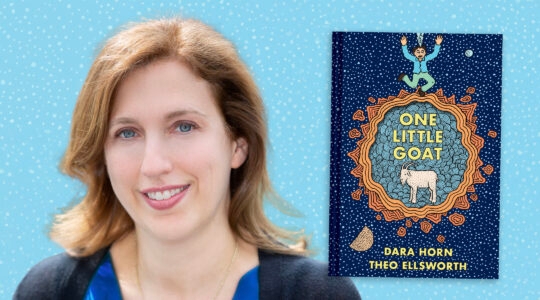My mother’s favorite story: Two Jews in post-Anschluss Vienna, walking through an anti-Semitic neighborhood. They see that they’re being followed by two Nazi thugs. One of the Jews says to his friend, “We better make a run for it. There are two of them, and we are all alone.”
This little story, perhaps better than any other, reflects the sense of anxiety that still characterizes Jewry in the 21st century. Historian Victor Tcherikover used to say that there are few things in the human chronicle that have a history of 2,000 years; anti-Semitism one of them.
Behavioral anti-Semitism — what people do — is an old story in contemporary Europe. The year 2002 and the first half of 2004 were terrible years, especially in France, and there have been sporadic outbreaks since. This year, too, is raising serious questions on the anti-Semitism front. The visibility of far-right parties in recent European Parliament elections, last week’s attack on a synagogue in Belgium and record aliyah from France are troubling indicators. Monitoring and counter-action are clearly called for.
While behavioral anti-Semitism is still a serious problem in some countries, the more interesting question is about attitudinal anti-Semitism — what do people think about Jews? On this fairly narrow question there are numerous findings, and the data from the new Anti-Defamation League survey, “ADL Global 100: The Index of Anti-Semitism,” are useful.
The “Index” used by the ADL is the 11-item list of anti-Semitic beliefs, which has been the central investigative device used by the ADL for decades. The index consists of scale made up of questions designed to detect anti-Semitism. Six or more “Probably True” answers make a person “infected” (ADL’s word) with anti-Semitism.
There are at least three serious flaws with the ADL index methodology, flaws that call into question how anti-Semitism is being studied in 2014. The problem is that the index, created in 1964, may reflect the societal realities of that era, but may not reflect the today’s realities. To be fair to the ADL, a number of the questions have changed in 50 years, but the thrust of the index is substantially the same as it was decades ago.
Some of the questions in the ADL/First International Resources poll indeed do target anti-Semitic attitudes. But, to take one example, consider the following question: “Jews don’t care what happens to anyone but their own kind.” My guess is that this question is not perceived by many respondents as reflecting negatively on Jews; in fact, it may not measure anti-Semitism. It’s the old “Jews-stick-together” question. This is anti-Semitism? Maybe it was in 1954 and 1964; it sure isn’t in 2014.
Indeed, it’s not clear to anyone that the index as a whole measures anti-Semitism. (Readers ought take the survey themselves. How do you measure up?)
Second, there is a basic ambiguity in the responses. A respondent who answered “Probably True” to six questions has been just fine on five. Yet that person is “infected” with anti-Semitic attitudes. Even among the “Anti-Semitic” there exist identifiable pro-Jewish attitudes. It’s not an “either/or” proposition — but the ADL says it’s, “Anti-Semitic!” Period.
And there’s the “Jewish power” question, long a staple of polls on anti-Semitism. No fewer than five questions (out of 11) in the ADL index are “Jewish power” questions. But the way in which the “Jewish power” question is asked makes all the difference. It should never be asked the way the ADL asks it: “Do Jews have too much power…?” Ask it that way, and you will always get high numbers, and the data will tell us very little. The “Jewish power” question ought always be asked contextually: “Which of the following groups have too much power?” followed by a list of religions and ethnic groups and other entities — Arab oil nations, the media, labor unions, Jews, Asians, Blacks, the Catholic Church, Hispanics, WASPs, the banks. When asked in this way, Jews consistently fall way down the list, at 8-10 percent, rather than the 25-34 percent in the ADL survey.
I have problems with the “Jewish power” question. My own sense is that, with respect to “Jewish power,” people are not anti-Semitic, they are anti-power. The issue is power, not Jews. People think that many groups have too much power.
Further, most attitudinal surveys are leading Jews toward a new definition of anti-Semitism, which is troubling — attitudes toward Jews that Jews find distasteful; attitudes that Jews wish “they,” namely non-Jews, would not have — rather than the classic definition of anti-Semitism as expressed hostility toward Jews for no good reason. The fact is that Jews in America and some other lands may very well be a power group; is it therefore unreasonable for some people to ask whether Jews have too much power?
In the end, the question is not anti-Semitism; it is Jewish security. How do the views reflected in surveys implicate Jewish security — the ability of Jews to participate in the society on a day-to-day basis, individually and communally? In the Americas, in Europe, in Asia in 2014, whatever the problems — and there are some serious ones — there are relatively few Jews who cannot participate in society because of fear of anti-Semitic animus.
We are in an era of intergroup conflict. The landmark “Authoritarian Personality” study taught us that lots of people don’t like lots of other people — even people who are not there! The 1990 General Social Survey (GSS) provided data on 58 ethnic groups — including one fictitious group, the “Wissians.” The GSS found that significant numbers of people hold negative attitudes toward the “Wissians!” This ought tell us something about perceptions around the world of Jews. Indeed, Jews may very well come off easy.
My mother’s second favorite joke: What’s a Jewish telegram? “Start worrying. Letter follows.”
Jerome Chanes, a frequent contributor, is the author of four books on Jewish public affairs and history — including three award-winning books on anti-Semitism.
The New York Jewish Week brings you the stories behind the headlines, keeping you connected to Jewish life in New York. Help sustain the reporting you trust by donating today.




